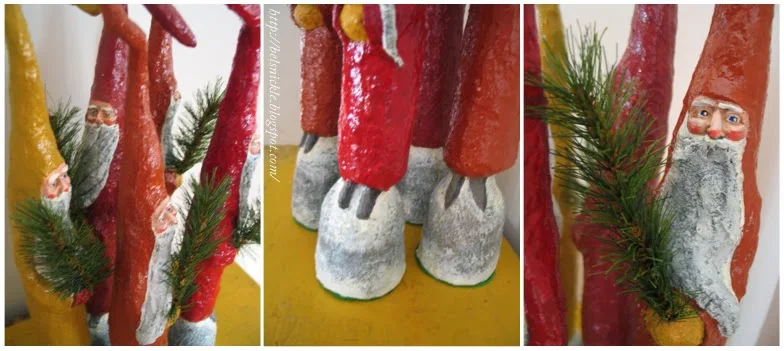 |
| Small boys surround a Christmas tree in 1905. |
It will not be the fault of the shop keepers if your Christmas tree is lacking in characteristic beauty, for as early as November first the toy departments were beginning to assume a "Christmasy" aspect.
The number of people who purchased decorations at that time was altogether surprising, and from the first week of November to Thanksgiving the buying has been unprecedented. There are two good reasons for early buying; the novelties, of course, quickly disappear and the stock becomes exhausted; again when purchased in ample time there is less danger of the frail ornaments being broken, which is sure to occur when the holiday rush is on for good and everybody is making for the same goal.
While there is nothing strikingly new or unusual among the fanciful embellishments for this year's Christmas tree, they are sufficiently satisfying and ornate to please the little men and women for whom they are intended, happy sojourners in the Land of Delusion.
It is probably owing to the small box-like rooms that prevail in recently built houses and the growing popularity of flat-life that brought the diminutive tree into favor. At any rate, real and artificial trees from 24 inches to 1 yard high and from this height to the fast vanishing giant balm that ends unwillingly beneath the ceiling are all equally desirable according to recent advice.
Every purchaser buys a tree best suited to the available space in his home. Children may trim and untrim small trees and so engage their time for days at a stretch, whereas with the usual size tree this is not possible. Besides, there is an economical side to the dwarf-like tree, which is vastly better than none at all, when a larger one proves too great a tax for a slender purse. The attendant annoyance of falling greens and the time required in trimming the trees are reduced to a minimum.
 |
| Babies underneath the tree in 1908. |
Small trees are also employed to bear the gifts for the children, which is even more fun than finding them under the tree.
A number of very attractive shapes are shown in colored glass ornaments, besides the standard ones that have been doing service for many years. The coloring this year seems to be unusually brilliant, three or four hues often being combined in one piece. Many of the more expensive ones are hand-painted and rainbow tinted, with queer little spirals of gilt running over and around them.
About a hundred and one different models for airships, some horizontally built, others like balloons swinging vertically, are in profuse assortment. These are mostly seen in a single color with spirals of gilt surrounding them. Boats, horns of plenty, besides hosts of others, may be added to the list. Many musical instruments are displayed alike in painted glass, with bright and dull finish.
Bunches of grapes in gold, silver, green and purple glass are available from 5 cents to 1$, and must assuredly be included among the essential decorations.
Miniature fans with the tops finished by frills of a plain color and enlivened with tinsel, ornate flowers, fancy heads and sparkling dust, are among the attractive novelties; these fans vary from three to six inches, the sticks are of gilt and silver paper, some of which are mounted on heavy cardboard.
The Christmas fairy does not flourish in her undisputed sway today as she did when we were nursery enthusiasts. But she is the same ornate fluffy spangled lady, sometimes wearing frilled skirts of gold paper, again one of coarse lace with paper flowers and bits of tinsel and stars or one of cotton net standing out in a characteristic, bouffant fashion.
Quite amusing are the little roly-poly decorations, dudes, Indians, clowns, dancing girls, besides those of the animal tribe, rabbits, dogs, cats, pigs, bears and what not, all fancifully garbed, with their bearing attached to swing on the tree.
Both plain and crepe papers enter largely into the fanciful designs of all sorts. Very graceful indeed are the horns of plenty of embossed gold and paper filled with flowers, some of which support a fairy butterfly, glistening with vari-colored diamond dust.
 |
| 1908, girls making ornaments for sale |
Large single flowers, the rose, chrysanthemum and sunflower, besides sprays are realistically designed in colored papers, their petals touched with gold and silver dust. Torpedo bonbons,
wishing bon bons gayly decorated with tinsel, fancy heads and flowers are fashioned of colored papers. These, it may be whispered, are not in the least difficult to make and very effective, and in white, scarlet, yellow, pale blue and pink make a good showing. I neglected to say that in some of the single flowers of crepe paper a little doll's face unexpected appears.
Among the most effective novelties handled by several houses are those of varicolored beads, made up into unique little ornaments. Many of these are of pendent persuasion and occasionally combined with glass beads, as in air ships, for example.
Strings of glistening glass beads and crystal shapes, some in one color shading from light to dark, again several colors alternating with each other, produce a most artistic effect when arranged in garland fashion. In pure white they catch and reflect light, like so many diamonds.
Crystal or glass fringe in gracefully shaped oval pendants of varying color add a refined brilliancy to the tree as a whole that seems unmatched by any other medium of decoration. Marjorie
Ornaments From The Gilded Age 1870 - 1900:
















































